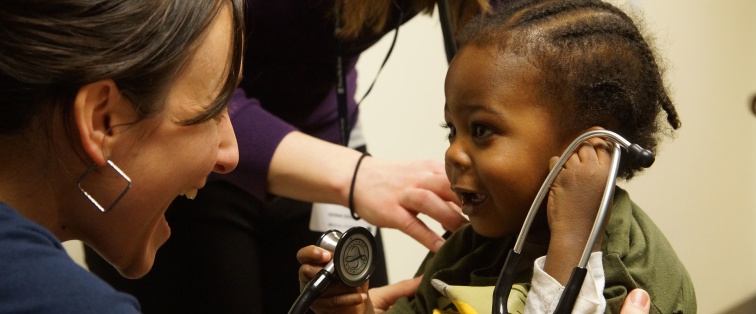Weaving Accountable Care and Intergenerational Family Services through Clinical and Community Models

Opportunities for intergenerational family services in pediatric accountable care organizations
Accountable care organizations (ACOs) bring together insurance payers and health care providers like doctors and hospitals to improve health care quality and coordination for their patients. ACOs and other risk-sharing contracts provide pediatric health systems and insurance payers with opportunities to test creative ways to improve care and lower costs while managing the health of populations. A promising opportunity for pediatric health systems in the ACO environment is the delivery of intergenerational family services – health care services provided to multiple family members, including adult caregivers, in the pediatric setting. Evidence shows that meeting parents’ medical needs is an effective way of improving children’s health. In fact, the American Academy of Pediatrics, the U.S. Preventive Services Task Force, the Centers for Medicare & Medicaid Services and the Maternal and Child Health Bureau have highlighted the integration of parental and pediatric health services. Insurance contracts, however, prevent pediatric practices from billing for adult services, creating a critical barrier to offering intergenerational family services in pediatric settings. ACOs may offer a remedy to this problem.
ACOs and similar innovative agreements between health systems and insurance payers seek to achieve the Triple Aim, which is to improve patients’ experiences of care and population health while reducing costs. When these goals are met, participants in the ACO contract may enjoy ‘shared-savings’ – the leftover dollars that result from improvements in care quality, coordination and efficiency as well as reductions in spending. It is then up to the insurance payer and health system to decide how best to allocate the money saved. Participants in a pediatric ACO contract could feasibly invest these savings in sustaining and expanding evidence-based intergenerational family services, possibly allowing organizations to side-step tricky reimbursement issues.
Medicaid-enrolled young mothers and their families could benefit greatly if their children are members of an ACO that provides intergenerational family services. New PolicyLab research echoes what has been found by many researchers: Low-income young mothers face significant health challenges at the time of the birth of a child, including serious mental illness, substance use, asthma and hypertension. Our study found, however, that over half of mothers with chronic health conditions who were receiving medication before pregnancy had discontinued their medications completely in the postpartum year, which may leave both mothers and their infants vulnerable to poor health and in some cases, serious harm. Successful management of these conditions requires treatment and monitoring by a health care professional.
In communities with high proportions of Medicaid enrollees, where the benefits of intergenerational family services may be most needed and cost-effective, a pediatric setting wishing to provide these services may face significant barriers. Among low-income families where multiple members have insurance coverage, it may be that each individual has a different type of coverage. For example, the parents of a Medicaid-enrolled child may not be enrolled in Medicaid themselves, or their Medicaid insurance policy may differ from their child’s. This insurance fragmentation, in addition to the payer’s credentialing requirements, restricts the ability of a pediatric setting to obtain reimbursement for services they might administer to the adult caregivers of their patients, making intergenerational models less feasible or sustainable.
Innovative service delivery and financing strategies
An ACO contract between a pediatric setting and a pediatric Medicaid payer could use analytical modeling to target priority populations and provide intergenerational family services. An ACO contract that incorporates shared-savings, for example, could support intergenerational family services for populations that are traditionally high-need and high-cost, and whose conditions and health care utilization could be ameliorated through these types of integrated interventions. An ACO that prioritizes a vulnerable population, such as young mothers with mental health issues, could support the co-location and integration of mental health services for caregivers of children in the pediatric setting. Although the insurance payer would not typically cover these services, the strong evidence associating poor parental health, inappropriate use of emergency departments and poor child health outcomes supports intergenerational family service delivery models that improve child health care utilization and outcomes.
Provider-level factors and administrative factors, such as logistical and privacy concerns around parental information within a child’s electronic health record, may impede the implementation and sustainability of intergenerational family services within pediatric settings. Yet, if a pediatric health care provider were able to demonstrate that the very intergenerational interventions being supported through the ACO result in improved health outcomes and reductions in utilization for its pediatric population, it may be possible to finance intergenerational family services through reinvestment of savings that those activities generate.
Setting up a reinvestment mechanism to support activities of an ACO is not a new concept. For example the Camden Coalition of Healthcare Providers adopted a gainsharing plan that outlines a shared savings reinvestment process for its ACO. Whereas shared savings targets cost reductions among a group of patients such as an ACO’s attributed population, gainsharing focuses on reducing costs or duplication of particular health care services. Both concepts may result in leftover dollars that can be used in a variety of ways to advance the activities of an ACO. In the Camden Coalition’s case, New Jersey state law and regulations require the ACO to reinvest shared savings in ACO activities such as incentive payments to providers for improved care quality and health outcomes, interdisciplinary collaboration, improved access to care for those at high-risk and expanded medical homes. Similar mechanisms have been implemented in different policy realms.
While this reinvestment concept may bring us closer to a better solution for intergenerational program sustainability, variability in an ACO’s year-over-year savings could make this strategy untenable. Efficiency improvements will eventually reach a ceiling, and the ACO participants will begin to observe diminishing financial returns. Perhaps a more logical approach is for the pediatric provider to partner with community agencies that administer dual-generation or adult-focused services, rather than establishing new services in the pediatric health care setting. For example, a pediatric setting that serves a large proportion of patients with young mothers who have mental health issues could partner with an organization that administers behavioral health services to adults and embed these services in the pediatric setting. This scenario reflects the ideas behind the Healthy Steps for Young Children program at the Children’s Hospital at Montefiore in Bronx, NY, where providers recognized the value of screening adult caregivers for behavioral health. Caregivers who were not accessing services elsewhere could be screened and even treated as part of their children’s pediatric visits, leading to more receptivity of behavioral health services, which often carry a stigma.
Another way to leverage community strengths in addressing determinants of health is utilizing accountable health communities (AHCo), which are scaled-up version of ACOs that transcend formalized partnerships between pediatric settings and community-based organization. An Altarum Institute brief describes reinvestment of health care cost savings as an AHCo sustainability strategy in maintaining and managing population health. Creating AHCos in a city like Philadelphia, which is saturated with health and social services agencies, could optimize the allocation of stretched resources to better serve children and families in need. But in order to attract their participation in an ACO or AHCo, these agencies must be incentivized. The Affordable Care Act requires non-profit hospitals to spend community benefit dollars by identifying and meeting health needs in their communities to maintain tax exemption. These funds, or grants from local foundations, could provide an initial infusion of funds to build a collaborative infrastructure and motivate community agencies to participate. An ultimate goal might be to build a fully-integrated system that offers comprehensive services to families, as Denver Health Community Health Services is achieving. As a public health focused network of community- and school-based health centers, Denver Health offers primary and specialty care services to individuals and families, as well as urgent and emergency care, plus paramedic services to the community. Denver Health approaches care for families using the life course perspective, addressing the medical, physical, behavioral and social needs of patients throughout the lifespan, with special attention paid to developmental stages.
As ACOs increasingly enter the pediatric space, innovative clinical and payment models that feature intergenerational family services represent a robust strategy to reduce costs while improving quality and health outcomes for children and families. The ACO framework could resolve financial barriers around developing intergenerational family services by generating a return on investment for the insurance payer and provider early on. A strategy for long-term sustainability could involve pediatric ACOs collaborating with community-based agencies to meet the needs of vulnerable caregivers who otherwise face barriers to health care. By stewarding and sustaining community partnerships, stakeholders could work toward building an integrated system oriented to intergenerational family services. Giving adult caregivers the opportunity to address their own physical and mental health needs will better equip them to keep their children healthy. At this important moment in health care reform, we can leverage ACOs to establish intergenerational family services and bring them to scale through community partnerships, ultimately improving the health of vulnerable populations.
